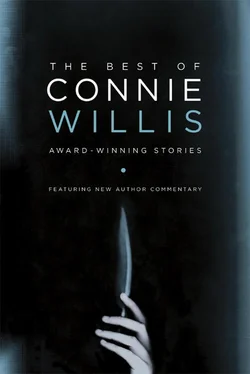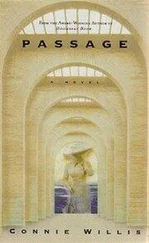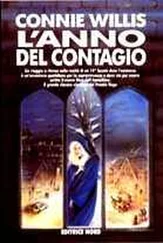“No,” I said and was saved by the Hugheses coming in right then, Mrs. Hughes, looking frail and elderly, and her strapping sons Milford Junior and Paul and their wives.
Introductions all around, and it developed that the blonde with Milford Junior wasn’t his wife, it was his fianceé. “Barbara and I just couldn’t talk to each other anymore,” he confided to me over cocktails. “All she was interested in was buying things, clothes, jewelry, furniture.”
China, I thought, looking across the room at Cath.
At dinner I was seated between Paul and Milford Junior, who spent the meal discussing the Decline and Fall of the British Empire.
“And now Scotland wants to separate,” Milford said. “Who’s next? Sussex? The City of London?”
“At least perhaps then we’d see decent governmental services. The current state of the streets and the transportation system—”
“I was in the Tube today,” I said, seizing the opening. “Do either of you know if Charing Cross has ever been the site of a train accident?”
“I shouldn’t wonder,” Milford said. “The entire system’s a disgrace. Dirty, dangerous—the last time I rode the Tube, a thief tried to pick my pocket on the escalator.”
“I never go down in the Tube anymore,” Mrs. Hughes put in from the end of the table where she and Cath were deep in a discussion of china shops in Chelsea. “I haven’t since Milford died.”
“There are beggars everywhere,” Paul said. “Sleeping on the platforms, sprawled in the passages. It’s nearly as bad as it was during the Blitz.”
The Blitz. Air raids and incendiaries and fires. Smoke and sulfur and death.
“The Blitz?” I said.
“During Hitler’s bombing of London in World War II, masses of people sheltered in the Tube,” Milford said. “Along the tracks, on the platforms, even on the escalators.”
“Not that it was any safer than staying aboveground,” Paul said.
“The shelters were hit?” I said eagerly.
Paul nodded. “Paddington. And Marble Arch. Forty people were killed in Marble Arch.”
Marble Arch. Blast and blood and terror.
“What about Charing Cross?” I asked.
“I’ve no idea,” Milford said, losing interest. “They should pass legislation keeping beggars out of the Underground. And requiring cabbies to speak understandable English.”
The Blitz. Of course. That would explain the smell of gunpowder or whatever it was. And the blast. A high-explosive bomb.
But the Blitz had been over fifty years ago. Could the air from a bomb blast have stayed down in the Tube all those years without dissipating?
There was one way to find out. The next morning I took the Tube to Tottenham Court Road, where there was a whole street of bookstores, and asked for a book about the history of the Underground in the Blitz.
“The Underground?” the girl at Foyle’s, the third place I’d tried, said vaguely. “The Tube Museum might have something.”
“Where’s that?” I asked.
She didn’t know, and neither did the ticket vendor back at the tube station, but I remembered seeing a poster for it on the platform at Oxford Circus during my travels yesterday. I consulted my tube map, took the train to Victoria, and changed for Oxford Circus, where I checked five platforms before I found it.
Covent Garden. The London Transport Museum. I checked the map again, took the Central Line across to Holborn, transferred to the Piccadilly Line, and went to Covent Garden.
And apparently it had been hit, too, because a gust of face-singeing heat struck me before I was a third of the way down the tunnel. There was no smell of explosives, though, or of sulfur or dust. Just ash and fire and hopeless desperation that it was all, all burning down.
The scent of it was still with me as I hurried upstairs and out into the market, through the rows of carts selling T-shirts and postcards and toy double-decker buses, to the Transport Museum.
It was full of T-shirts and postcards, too, all sporting the Underground symbol or replicas of the tube map. “I need a book on the Tube during the Blitz,” I asked a boy across a counter stacked with “Mind the Gap” place mats and playing cards.
“The Blitz?” he said vaguely.
“World War II,” I said, which didn’t elicit any recognition, either.
He waved a hand loosely to the left. “The books are over there.”
They weren’t. They were on the far wall, past a rack of posters of tube ads from the twenties and thirties, and most of what books they had were about trains, but I finally found two histories of the Tube and a paperback called London in Wartime . I bought them all and a notebook with a tube map on the cover.
The Transport Museum had a snack bar. I sat down at one of the plastic tables and began taking notes. Nearly all the tube stations had been used as shelters, and a lot of them had been hit—Euston Station, Aldwych, Monument. “In the aftermath of the bombing, the acrid smell of brick dust and cordite was everywhere,” the paperback said. Cordite. That was what I had smelled.
Marble Arch had taken a direct hit, the bomb bursting like a grenade in one of the passages, ripping tiles off the walls as it exploded, sending them slicing through the people sheltered there. Which explained the smell of blood. And the lack of heat. It had been pure blast.
I looked up Holborn. There were several references to its having been used as a shelter, but nothing in any of the books that said it had taken a hit.
Charing Cross had, twice. It had been hit by a high-explosive bomb, and then by a V-2 rocket. The bomb had broken water mains and loosed an avalanche of dirt down onto the room containing the escalators. That was the damp earthiness I’d smelled—mud from the roof collapsing.
Nearly a dozen stations had been hit the night of May 10, 1941: Cannon Street, Paddington, Blackfriars, Liverpool Street—
Covent Garden wasn’t on the list. I looked it up in the paperback. The station hadn’t been hit, but incendiaries had fallen all around Covent Garden, and the whole area had been on fire. Which meant that Holborn wouldn’t have to have taken a direct hit, either. There could have been a bombing nearby, with lots of deaths, that was responsible for Holborn’s charnel house smell. And the fact that there had been fires all around Covent Garden fit with the fact that there hadn’t been sulfur, or concussion.
It all fit—the smell of mud and cordite in Charing Cross, of smoke in Cannon Street, of blast and blood in Marble Arch. The winds I was feeling were the winds of the Blitz, trapped there by London’s inversion layer, caught belowground with no way out, nowhere to go, held and recirculated and intensified through the years in the mazelike tunnels and passages and pockets of the Tube. It all fit.
And there was a way to test it. I copied a list of all the stations I hadn’t been to that had been hit—Blackfriars, Monument, Paddington, Liverpool Street. Praed Street, Bounds Green, Trafalgar Square, and Balham had taken direct hits. If my theory was correct, the winds should definitely be there.
I started looking for them, using the tube map on the cover of my notebook. Bounds Green was far north on the Piccadilly Line, nearly to the legendary Cockfosters, and Balham was nearly as far south on the Northern Line. I couldn’t find either Praed Street or Trafalgar Square. I wondered if those stations had been closed or given other names. The Blitz had, after all, been fifty years ago.
Monument was the closest. I could get there by way of the Central Line and then follow the Circle Line around to Liverpool Street and from there go on up to Bounds Green. Monument had been down near the docks—it should smell like smoke, too, and the river water they’d sprayed on the fire, and burning cotton and rubber and spices. A warehouse full of pepper had burned. That odor would be unmistakable.
Читать дальше












